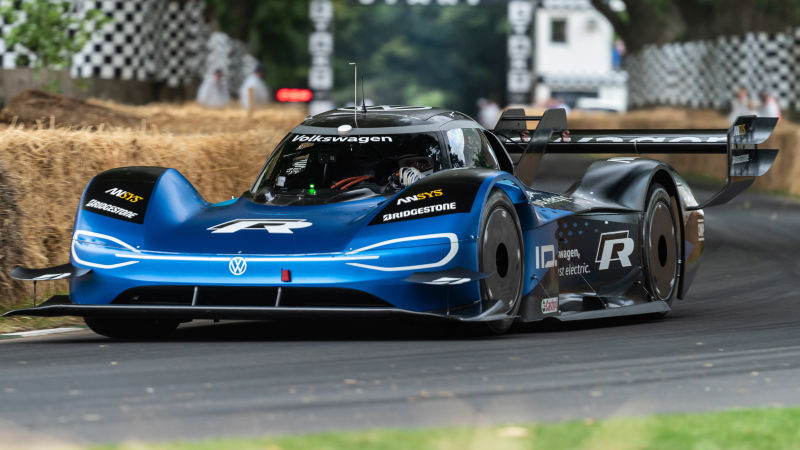
At this weekend’s Goodwood Festival of Speed, the electric Volkswagen ID.R EV prototype didn’t only beat but smashed the record for the event’s hill climb by flying up in 39.9 seconds. The previous record of 41.6 seconds was set by Nick Heidfeld in a McLaren MP4/13 Formula One car in 1999.
Ultimately and disappointingly, Goodwood confirmed that due to wet weather the ID.R couldn’t set a record at Sunday’s shootout, so the old record stands.
For now.
What’s indisputable is that the ID.R has been on a bit of a record breaking run of late. At Pikes Peak and the Nürburgring, it has set new hot lap targets thanks to EV power. It’s not done yet, either. And so far it’s a high-profile example of just how potent electric cars can be, an antidote to the dated thinking that they’re just golf carts for environmentally conscious people.
I spoke to Sven Smeets, VW’s Motorsport Director, about the car, and what we can expect in future.
Advertisement
Now, this car isn’t quite the same one we saw smash the ‘Ring EV record: “We have reduced the weight of the car quite a lot, we have a smaller battery because the big battery from Pikes Peak or the Nürburgring you don’t need here,” Smeets said. “We surprised ourselves a little bit.”
In Pikes Peak spec last year, the car was running a 43 kWh battery with an electric motor at each axle, and put down about 680 horsepower. It could do zero to 60 mph in a bit over two seconds. It only weighs about 2,400 pounds.
Advertisement

The team came to break Heidfeld’s 1999 record. It seems they knew it could happen, but it wasn’t going to be straightforward.
Advertisement
“We came to break the record, that was the aim with perfect conditions,” Smeets said. “You go with cold tires to the start and then you wait another hour, which is not ideal for a 2.2 km track. We knew we could break the record but to get under the 40 second mark is quite an achievement, beyond what we hoped for. We hoped to go under 41, then you’re the only car [under 41 seconds]. But to go below 40… well, the package seemed to be right.”
The car broke the hill’s record (officially or not) on Saturday’s shootout qualifying run, not during the competitive shootout on Sunday. Sunday, the Festival’s final day, was utterly miserable. Rain, wind, typical British summer stuff, which wasn’t ideal for breaking records at all.
Advertisement
And while the weather lifted later on, Dumas didn’t break his own record again putting in a still damn quick 42.32 second time. But could the car have gone faster than it had the day before?
“They say it always can go a little faster,” Smeets said. “But with the run from last night, today… we could try to get again a little more out of every component, Romain could do this little touch more, but with the run last night we were very happy.”
Advertisement

Smeets said that the ID.R has been a steep learning curve for VW Motorsport, which is a division of an automaker making an all but unprecedented mass production shift to EVs. While the VW racing team knows its onions when it comes to rally and other rough stuff, it’s never tackled prototypes before.
Advertisement
Or, for that matter, EV prototypes. “We have learned a lot about battery management, and energy management,” Smeets said. “But doing this year and the testing between the races, we really started to understand our car better and better. We also had a steep learning curve with the chassis.”
Advertisement
For the moment, it seems that the ID.R is capable of taking on everything thrown at it. But energy management tech is changing rapidly, and the ID racer could evolve to match.
“I’m quite sure if we, because we are thinking what to do next, and what to do next is create some IDs that are more extreme,” he said. “The battery technology and everything around e-mobility is like a rollercoaster of development. What’s new today will be old in six months. More and more people are looking in to it. I compare it to the early days of turbo cars: ‘Today I may be driving this, but in eight months I’ll be driving something better.’ This is what’s happening with battery technology. I’d not be surprised that other things can be done in a year, a year and half. More range with really high performance.”
Advertisement

The ID.R has been handy for road car development, passing on relevant data for energy and battery management. As Smeets says: “In testing we are allowed to do something wrong, which you can’t do in production cars.”
Advertisement
What about future EV motorsport? Could we see a switch to EVs competing at similar lengths, in endurance races? Almost like an electric version of what Formula E is doing.
Well, Smeets said: “Not tomorrow, not in 2020, but it will come. The tech is growing so fast, and we already see that FE is doing 40-minute races. Longer than a touring car race today.”
Advertisement
What we know is that the ID.R is a record breaker, and in at the ground level of extreme electric motorsport.
Going fastest here, and elsewhere, has proved there’s serious mileage in the tech, but a quick scan of twitter (well, my feed at last), and overhearing people talking about the car at Goodwood, shows some doubts about whether it’s a good thing. Some don’t like it because it’s an EV, which simply doesn’t excite them, others dislike it because they want to know what a modern F1 car (which can’t compete) would manage up the hill.
Advertisement
No matter which way you look at it, it’s an incredible achievement. The EV revolution is coming slowly but surely, and it’s going to be pretty brisk.













